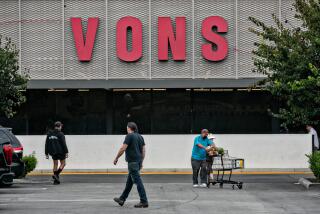Gift Returns Can Be Biggest Holiday Hassle
- Share via
Does Christmas shopping seem a hassle? Compared to the day after Christmas, it’s a breeze.
For retailers, that day brings the year’s biggest traffic and the third-biggest sales volume, cut by the biggest volume of returns--a single day getting “a buildup of over four weeks of buying,” says Charles Zahka, vice president of consumer services for the Broadway stores in Southern California. Thus, it’s both good and bad for retailers, and, feeling the pressure, they show their true colors in how they handle it.
For consumers, it’s big crowds and the likelihood of skirmishes with stores demanding better proof that the goods were theirs or refusing to credit more than the after-Christmas sale price. Some stand tough because in the short run, it’s more profitable. Others are lenient because, says Holly Tatson, manager of customer service at Marshall Field’s in Chicago, “we hope to build good will at this time of year.”
Where they exist, state and municipal laws governing return policies generally only require that a policy be disclosed to the purchaser. Few concern themselves with specific terms, although New York state says any retailer that doesn’t disclose its policies must offer a choice of cash or credit within 20 days of purchase.
Gift returns are a special problem rarely addressed by policy or posting. The gift returner was not the purchaser, and there’s often no sales receipt to prove the origin, purchase date or price of the goods. Most stores also give Christmas returns special treatment, not because of Christmas spirit, but for expediency, given the sheer number and concentration of returns. Many also recognize the marketing opportunity in “people who came in only because they received a gift,” Zahka says. “It gives us a crack at building new customers.”
Many big stores--department and chain--say they’re more liberal about gift returns at Christmas because they’re so committed to giving service. It obviously helps if the consumer has kept the original packing, but a surprising number of stores say that if they carry the item at all, they’ll take the shopper’s word that it came from their store. “The only exception would be something bearing another store’s label,” says Kathleen Waugh, spokesman at the Atlanta headquarters for Macy’s South and Bullock’s stores.
Most will give cash as well as credit or exchange, a custom that might please the person making the return but not the gift giver, who would have given cash himself had he wanted to. If it’s over a certain amount, some send a check--a system that could reveal a suspicious number of returns by any one person, who may be stealing goods just for their return value.
Small stores are another matter: They usually give credits rather than cash, though their limited selections make it more difficult to use them up. Some say their cash flow is too precarious. Some are just shortsighted. Some are too involved psychologically: At small stores, says Joseph B. Siegel, vice president of merchandising at the National Retail Merchants Assn. in New York, “the owner is on the floor and recognizes it’s money they’d be losing.”
Service philosophies and efficiency break down somewhat when it comes to the amount of refund. Almost all stores disingenuously promise to refund full “purchase price,” as verified by sales receipt. The problem is that such prices self-destruct on Christmas Day. Immediately thereafter, they’re marked down 20% of the original price, says Siegel, then 30%, 40% by end-of-January inventory, 50% in early February--a sequence complicated, but not necessarily altered, by all of today’s pre- Christmas sales.
Without a sales slip, the customer gets the current price on the item, or so say almost all the stores annually surveyed by the Better Business Bureau of Metropolitan New York. This foils the petty con artist who would rip off a store by buying goods at post-Christmas prices and claiming that they were pre-Christmas purchases. Instead, the store rips off its customers because most of the Christmas gifts being returned were bought before Christmas, undoubtedly at a higher price.
There’s a simple solution to the question of price--practiced by some, noted by a few (including this column over several years), known to all. Stores could include a notation of the purchase date, if not price, with every purchase, thereby settling all questions. Unfortunately, no one wants to talk about this solution, out of fear that people would then rip them off by altering the notation.
Nevertheless, such notations are being made, in various ways, variously helpful. Some stores put a note on all boxes that are specially gift-wrapped--a small percentage of purchases. Marshall Field includes coded notations in all boxes, and all sales counters provide boxes at Christmas.
Seattle-based Nordstrom stores have put slightly scrambled information about date, price and salesperson on all goods for years, and year-round. Other stores are starting to follow the custom, and it’s not just because they’re big on service. More and more retailers, especially department stores, are putting their salespeople on commissions, and the notations guarantee that credit for the sale can be properly given and properly reversed if something is returned.
For customers contemplating returns, however, it would be a real service. Consumers buying gifts might insist on date notations whether it’s store custom or not. For retailers, it’s little trouble, although they do run that risk of altered notations, and they will lose the money they make by refunding less than was spent.
There are more important gains, and Siegel, for one, is sanguine that stores would recognize and welcome them: “They’d be delighted to do it,” he says, “because it avoids argument.”
More to Read
Inside the business of entertainment
The Wide Shot brings you news, analysis and insights on everything from streaming wars to production — and what it all means for the future.
You may occasionally receive promotional content from the Los Angeles Times.










